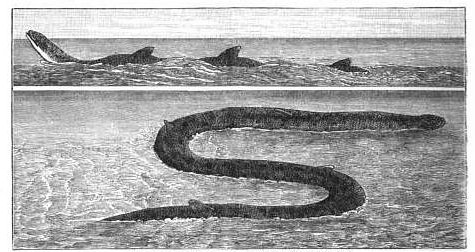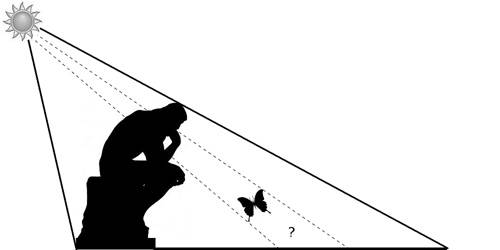George Story was aptly named: He appeared as a baby in the first issue of Life magazine in 1936, and he died 63 years later — as the magazine announced it was ceasing publication.
Oddities
In a Word
remontado
n. one who has left civilization and returned to the wilderness
Sarah Bishop was a young lady of considerable beauty, a competent share of mental endowments and education; she possessed a handsome fortune, but was of a tender and delicate constitution, enjoyed but a precarious state of health, and could scarcely be comfortable without constant recourse to medicine and careful attendance. She was often heard to say that she had no dread of any animal on earth but man. Disgusted with her fellow-creatures, she withdrew from all human society, and at the age of about twenty-seven, in the bloom of life, resorted to the mountains which divide Salem from North Salem: where she has spent her days to the present time, in a cave, or rather cleft of the rock, withdrawn from the society of every living being.
— G.H. Wilson, The Eccentric Mirror, 1813
A Watery Welcome

On May 13, 1872, the barque St. Olaf was sailing from Newport to Galveston when a crewman called out that “he saw something rising out of the water like a tall man”:
On a nearer approach we saw that it was an immense serpent, with its head out of the water, about 200 feet from the vessel. He lay still on the surface of the water, lifting his head up and moving the body in a serpentine manner. We could not see all of it, but what we could see from the after-part to the head was about 70 feet long, and of the same thickness all the way, excepting about the head and neck, which were smaller, and the former flat like the head of a serpent. It had four fins on its back, and the body of a yellow, greenish colour, with brown spots all over the upper part, and underneath white.
The weather was calm, the sea smooth. “The whole crew were looking at it for fully ten minutes before it moved away,” Captain A. Hassel reported later. “It was about 6 feet in diameter.”
The Dyatlov Pass Incident
In February 1959, a search was organized when nine Russian ski hikers failed to return from a trek in the northern Ural Mountains. After six days, their abandoned camp was found in a mountain pass.
All the hikers were dead. Two were found on the opposite side of the pass, near the remains of a fire; three others had died closer to camp, apparently trying to return; and the remaining four were found only three months later, under 4 meters of snow in a nearby stream valley.
Apparently the victims had fled the tent suddenly on the night of Feb. 2, tearing their way out from the inside and running down the mountain. Though the temperature had been around -25° C, all were inadequately dressed, some wearing only underwear. Though the bodies had no external wounds, one showed severe skull damage and two had major chest fractures. One woman’s tongue was missing.
In the end, Soviet investigators could conclude only that a “compelling unknown force” had caused the hikers’ deaths. That’s all that’s known.
Discount Travel

When 5-year-old May Pierstorff asked to visit her grandmother, her parents had no money to buy a rail ticket.
So they mailed her.
On Feb. 19, 1914, May’s parents presented her at the post office in Grangeville, Idaho, and proposed mailing her parcel post to Lewiston, some 75 miles away. The postmaster found that the “package” was just under the 50-pound weight limit, so he winked at their plan, classed May as a baby chick, and attached 53 cents in stamps to her coat. May passed the entire trip in the train’s mail compartment–and was duly delivered to her grandparents in Lewiston by mail clerk Leonard Mochel.
“The Candle-Fish of British Columbia”
There is found, in some of the rivers of British North America, a species of smelt so rich in oil that it may when dried be used as a candle or torch. … At certain seasons the fish swarms up the rivers from the sea, and is then caught by the natives in wickerwork traps. … When a candle is required a dried fish is stuck, tail upwards, in a lump of clay or in a cleft stick; a light is applied to the tail, which instantly flames up, and the fish burns steadily downward, giving a light superior to that of the best quality of ‘dips.’
— The World of Wonders, 1883
“Sparkling Rain”
Rain which on touching the ground crackles and emits electric sparks is a very uncommon but not unknown phenomenon. An instance of the kind was recently reported from Cordova, in Spain, by an electrical engineer who witnessed the occurrence. The weather had been warm and undisturbed by wind, and soon after dark the sky became overcast by clouds. At about 8 o’clock there came a flash of lightning, followed by great drops of electrical rain, each one of which, on touching the ground, walls, or trees, gave a faint crack, and emitted a spark of light. The phenomenon continued for several seconds, and apparently ceased as soon as the atmosphere was saturated with moisture.
— Western Daily Mercury, Nov. 1, 1892, quoted in Symons’s Monthly Meteorological Magazine, December 1892
A Delicate Matter
In 1926 an English probate court accepted a will written on an empty eggshell.
A Manchester widow had found the shell on her husband’s wardrobe. On it was written, “17-1925. Mag. Everything i possess. — J. B.”
The dead man had been dieting and used to bring eggs with him to work. His initials had been J.B., the message was in his handwriting, and he had always called his wife “Mag.” The court accepted the shell as a valid will (Hodson v. Barnes, 1926).
See also Let’s Get This Over With.
Birth of a Nation
American businessman Russell Arundel and his friends were drinking rum in a Nova Scotia fishing lodge in 1948 when they got blearily ambitious: They drew up a declaration of independence for tiny Outer Bald Tusket Island, renaming it Outer Baldonia:
Fishermen are endowed with the following inalienable rights: The right to lie and be believed. The right of freedom from questioning, nagging, shaving, interruption, women, taxes, politics, war, monologues, cant and inhibition. The right to applause, vanity, flattery, praise and self-inflation. The right to swear, lie, drink, gamble and be silent. The right to be noisy, boisterous, quiet, pensive, expansive and hilarious.
Baldonia’s currency, they declared, was the tunar; all citizens who caught bluefin tuna would be named princes; and exports would include empty rum and beer bottles. Women were banned — though an exception was eventually made for Arundel’s former secretary, “princess” Florence McGinnis, because “I was doing all the paperwork.”
Baldonia made a modest name for itself: It was recognized in the Washington D.C. telephone directory, and Rand McNally put it on a map. But Arundel tired of the joke and eventually sold the island to the Nova Scotia Bird Society — he’d spent only one night in the “royal palace,” he said, and found it “windy, cold, and miserable.”
In the Dark
Here are two principles about shadows:
- They don’t pass through opaque objects. Your shadow can fall on a wall, but not through it.
- Light must strike an object in order to cast a shadow. If you’re in the shade, you have no shadow.
Right? But now suppose the sun is behind you and you’re contemplating a butterfly:

The shadow under the butterfly is not cast by you (Principle 1), and it’s not cast by the butterfly (Principle 2). So what’s casting it?
“This is a genuine problem,” writes philosopher Robert Martin. “The rules for shadows aren’t inconsistent, but they are empirically inadequate — there are phenomena they do not fit.”
